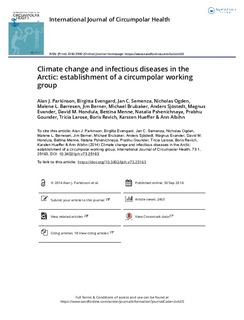Climate change and infectious diseases in the Arctic: Establishment of a circumpolar working group
| dc.contributor.author | Parkinson, Alan J | |
| dc.contributor.author | Evengard, B | |
| dc.contributor.author | Semenza, Jan C | |
| dc.contributor.author | Ogden, Nicholas | |
| dc.contributor.author | Børresen, Malene L | |
| dc.contributor.author | Berner, J | |
| dc.contributor.author | Brubaker, Michael | |
| dc.contributor.author | Sjöstedt, Anders | |
| dc.contributor.author | Evander, Magnus | |
| dc.contributor.author | Hondula, David M | |
| dc.contributor.author | Menne, Bettina | |
| dc.contributor.author | Pshenichnaya, Natalia | |
| dc.contributor.author | Gounder, Prabhu | |
| dc.contributor.author | Larose, Tricia L | |
| dc.contributor.author | Revich, Boris | |
| dc.contributor.author | Hueffer, Karsten | |
| dc.contributor.author | Albihn, Ann | |
| dc.date.accessioned | 2019-09-09T05:50:30Z | |
| dc.date.available | 2019-09-09T05:50:30Z | |
| dc.date.created | 2015-01-20T13:51:33Z | |
| dc.date.issued | 2014 | |
| dc.identifier.citation | International Journal of Circumpolar Health. 2014, 73 1-7. | nb_NO |
| dc.identifier.issn | 1239-9736 | |
| dc.identifier.uri | http://hdl.handle.net/11250/2613830 | |
| dc.description.abstract | The Arctic, even more so than other parts of the world, has warmed substantially over the past few decades. Temperature and humidity influence the rate of development, survival and reproduction of pathogens and thus the incidence and prevalence of many infectious diseases. Higher temperatures may also allow infected host species to survive winters in larger numbers, increase the population size and expand their habitat range. The impact of these changes on human disease in the Arctic has not been fully evaluated. There is concern that climate change may shift the geographic and temporal distribution of a range of infectious diseases. Many infectious diseases are climate sensitive, where their emergence in a region is dependent on climate-related ecological changes. Most are zoonotic diseases, and can be spread between humans and animals by arthropod vectors, water, soil, wild or domestic animals. Potentially climate-sensitive zoonotic pathogens of circumpolar concern include Brucella spp., Toxoplasma gondii, Trichinella spp., Clostridium botulinum, Francisella tularensis, Borrelia burgdorferi, Bacillus anthracis, Echinococcus spp., Leptospira spp., Giardia spp., Cryptosporida spp., Coxiella burnetti, rabies virus, West Nile virus, Hantaviruses, and tick-borne encephalitis viruses. | nb_NO |
| dc.language.iso | eng | nb_NO |
| dc.publisher | Taylor & Francis | nb_NO |
| dc.rights | Navngivelse 4.0 Internasjonal | * |
| dc.rights.uri | http://creativecommons.org/licenses/by/4.0/deed.no | * |
| dc.title | Climate change and infectious diseases in the Arctic: Establishment of a circumpolar working group | nb_NO |
| dc.type | Journal article | nb_NO |
| dc.type | Peer reviewed | nb_NO |
| dc.description.version | publishedVersion | nb_NO |
| dc.source.pagenumber | 1-7 | nb_NO |
| dc.source.volume | 73 | nb_NO |
| dc.source.journal | International Journal of Circumpolar Health | nb_NO |
| dc.identifier.doi | 10.3402/ijch.v73.25163 | |
| dc.identifier.cristin | 1202567 | |
| dc.description.localcode | © 2014 Alan J. Parkinson et al. This is an Open Access article distributed under the terms of the Creative Commons CC-BY 4.0 International License (http://creativecommons.org/licenses/by/4.0/ | nb_NO |
| cristin.unitcode | 194,65,20,0 | |
| cristin.unitname | Institutt for samfunnsmedisin og sykepleie | |
| cristin.ispublished | true | |
| cristin.fulltext | original | |
| cristin.qualitycode | 1 |

